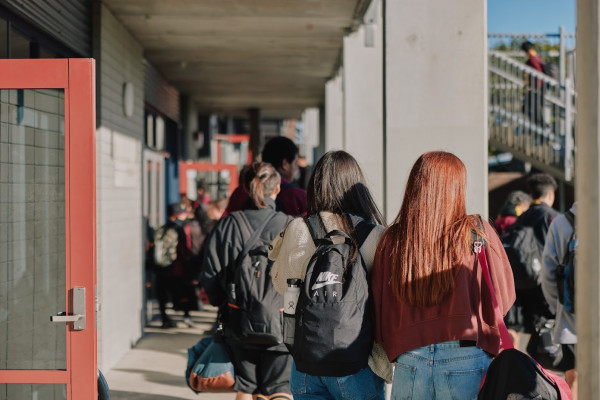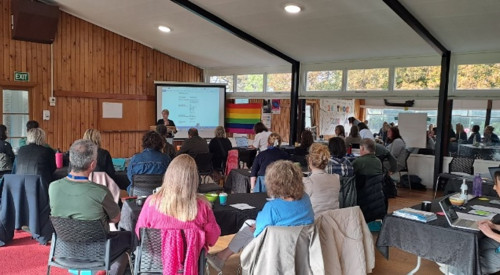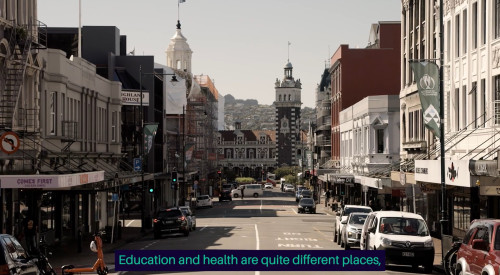How can schools better handle student mental health and wellbeing? Insights from NZCER's secondary principals' survey
Research 25 March 2024
In November 2023, the results of a 2022 nationwide survey of secondary school principals in Aotearoa revealed that the top issue they ranked dealing with at school was providing support for students grappling with mental health or wellbeing issues.
This begs the question, why is student mental health such a big concern right now? And, more importantly, what can schools be doing to better support their students?
Since 2003, the New Zealand Council of Educational Research (NZCER) has been conducting its tri-yearly survey, which explores various facets of the school experience, including student support, governance, wellbeing, curriculum, and working environment.
In the most recent survey, the research team engaged with approximately 150 principals, representing around 40% of English-medium secondary schools, along with 900 school staff members who completed the survey.
Principals were asked to select issues from a list that applied to their school. An 80% share of those who responded cited providing wellbeing support for vulnerable students as an issue they faced, up from 66% in 2018.
Schools staff overworked
Only 9% of principals reported finding their workloads ‘manageable’ and a 22% share thought their high workload prevented them from doing justice for their school.
Mohamed Alansari, the survey’s lead researcher, notes that a key finding of the project is that schools with a higher percentage of students facing material hardship often feel that the mental health support they receive doesn't meet their specific needs and context.
Alansari says that about 90% of principals indicated they have school-wide support plans for things like addressing racism and providing social support groups for rainbow kids, but just over two-thirds of school staff indicated the same thing.
However, one of the challenges in the school context is how such support-plans are communicated and how they are implemented across the school ecosystem “One of the things to be mindful of is whether or not these plans are communicated at the classroom or syndicate level,” Alansari says.
This is where whole-school approaches (WSA), whether this be for bullying prevention, increasing inclusivity or mental health are important. A WSA can help ensure that everything within a school, from pastoral responses to curriculum to school policy, is aligned and consistent. One example of a WSA centred around student health and wellbeing is Tūturu.
To view the full results of NZCER’s secondary principals survey, see here.
How Tūturu can help schools respond to student mental health?
Tūturu is a modern, holistic approach to student wellbeing that is focussed on ensuring students stay in school and are healthy and well. It aims to empower students through bringing together schools and health providers to equip students with critical thinking skills and health competencies.
Leaning into extra-curricular activities
Responding to growing rates of young people reporting emotional and mental distress consistently, the evidence points to the importance of schools using a multi-faceted approach to respond. Such a response would include:
· Providing students easy access to a range of extra-curricular activities.
· Implementing curriculum responses in the early years of secondary school aimed at developing mental health literacy.
· School-based health services.
· Fostering partnership between health providers and schools.
With the increasing pressure on teachers, there is simultaneously a growing need in the youth population for schools to provide whole-of-person responses. Whole-of-person education fosters critical thinking and challenges students to draw their own conclusions about particular issues. However, Alansari notes that these models can place additional pressure on teachers.
According to Alansari, school staff are aware of the need to understand the world of the child to help deal with their concerns but often feel under-prepared or under time pressure. "They [staff] always tell us ‘Well, I've got this amount of time and this amount of work, and I don't know how to do justice to all my students and their communities as well,” he says.
Through providing professional learning and development opportunities for staff, Tūturu has found some success in capacity building. The 2020 NZCER evaluation of Tūturu stated that PLD for deans and pastoral teams was a core driver of students experiencing issues with alcohol and other drugs being identified early and directed to support options, if needed.
Following on from this, a key step in improving mental health and wellbeing outcomes for secondary students would be for schools to embed more health and education workforce development programs in their training for staff.
Another issue presenting a roadblock to progress on student mental health in NZ secondary schools is the lack of training provided for teachers in the health and wellbeing areas. Alansari used to work at the University of Auckland’s Faculty of Education and Social Work, teaching on some initial teacher education courses. He did not think that teachers are well prepared to talk about mental health and wellbeing. “Back then, there weren’t more than a couple of hours, a lecture or two, during the whole program where students explicitly learned about strategies to support and promote mental health and wellbeing.” Now though, there are things like mental health education and Hauora resources (primary resource, secondary resource).
So, while some schools around the country are making progress and implementing evidence-based solutions to better address student health and wellbeing, it is clear there is still much work ahead.

Employing more counsellors is only part of the solution
A critical shortage of qualified counsellors available to help young people in schools recently led the Ministry of Education to loosen the criteria as to who would be eligible to participate in their Counsellors in School programme.
The lack of mental health services for young people goes beyond schools. A recent Mental Health and Wellbeing Commission report showed one in four young people (aged 12-17) in need of mental health care were being admitted to adult services due to a lack of age-appropriate units around the country
It’s clearly problematic if students are wrestling with issues in their personal life and are unable to connect with a professional to talk about what’s going on for them. That said, in addition to the urgent need of us having more counsellors available for our rangatahi, taking a holistic view of young people’s wellbeing at school involves a broader suite of solutions.
Equipping students with knowledge to make informed health decisions
Students’ success at school is connected to their overall health and wellbeing and the evidence shows that preparing students with critical thinking skills around health can help them better deal with a range of wellbeing issues that may crop up during their high school years.
If your school is interested in developing a connected approach to student wellbeing that is evidence-based, brings together health services and schools and works with educators on school climate, PLD, pastoral care and produces curriculum resources for schools to use, you can find out more about Tūturu here.
Recent news

What Tūturu is learning about youth gambling this Gambling Harm Awareness Week
2 September 2024
This Gambling Harm Awareness Week (2-8 September 2024), we want to highlight the health impacts gambling can have on young people, and what we want to do about it.

Supporting Students: A Wellbeing Lens – Dunedin Tūturu Whole School Approach Day 2024
2 July 2024
In May, schools from throughout Otago and staff from orgs such as Te Whatu Ora, NZ Police and MOE gathered to hear from a range of speakers on how best to meet the needs of secondary school students.

Tūturu in Ōtepoti Dunedin
19 February 2024
Whakaata Tohu Tohu | Mirror Services, works with multiple schools in Ōtepoti.